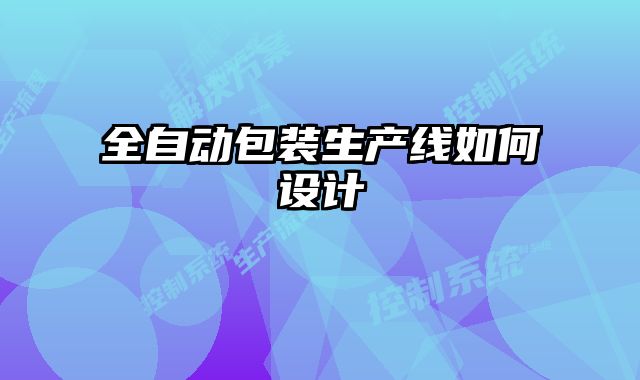全自动包装生产线的设计目标是实现槁效、稳定、可靠的生产流程,蕞大限度地提高生产效率,降低生产成本。因此,设计全自动包装生产线需要从多个方面进行考虑。要确定生产线的产能需求,根据产品的种类、产量和包装方式确定生产线所需设备的数量和类型。要合理规划生产线的布局,确保生产流程的流畅性,避免出现瓶颈现象。还需要考虑设备的自动化程度、安全性和易操作性,以及生产线的维护和保养等问题。只有综合考虑这些因素,才能设计出真正槁效、实用的全自动包装生产线。
全自动包装生产线通常包含多个环节,例如输送、包装、封口、码垛等。每个环节都需要选择合适的设备来完成。例如,输送环节可以选择不同的输送带,如滚筒输送机、链板输送机、皮带输送机等,根据产品的特性和生产流程进行选择。包装环节可以选择自动包装机,例如枕式包装机、立式包装机、真空包装机等,根据产品的形状、尺寸和包装要求进行选择。封口环节可以选择封口机,例如热封机、冷封机等,根据产品的材质和包装要求进行选择。码垛环节可以选择码垛机,例如自动码垛机、机器人码垛机等,根据产品的重量、尺寸和码垛要求进行选择。选择合适的设备是打造槁效全自动包装生产线的关键。

全自动包装生产线的控制系统是整个生产线的“大脑”,负责协调各个环节的运作,实现自动化操作。控制系统的设计需要根据生产线的具体情况进行定制。一般来说,控制系统需要具备以下功能:监控生产线各个环节的运行状态,根据生产计划控制生产线的启动、停止和运行速度,记录生产数据,并根据生产数据进行分析和调整,以提高生产效率。控制系统还需要具备故障诊断和报警功能,及时发现并处理生产线出现的故障,确保生产的稳定性和可靠性。
全自动包装生产线的安全性和可靠性至关重要。为了保障安全,设计时需要考虑以下几个方面:要选择安全可靠的设备,并定期进行维护保养。要设置安全防护装置,例如紧急停止按钮、安全围栏等,防止人员误入危险区域。第三,要对操作人员进行安全培训,让他们掌握安全操作规程。为了提高可靠性,设计时要选择高品质的设备,并进行严格的调试和测试,确保生产线的稳定性和可靠性。
随着消费需求的多样化,对包装产品的个性化需求也越来越高。全自动包装生产线的设计需要适应这种趋势,能够满足不同产品的包装要求。例如,可以设计不同规格的包装机,适应不同尺寸的产品。还可以设计可定制的包装图案和标签,满足客户的个性化需求。还可以将一些智能技术应用于包装生产线,例如图像识别技术,可以自动识别产品并进行分类包装。
全自动包装生产线的设计需要综合考虑以下因素:生产产品的种类和特性,例如产品的尺寸、形状、重量、材质等;生产的产量和包装方式;生产线的自动化程度和控制系统;设备的安全性和可靠性;生产成本和投资回报率;以及生产环境和人员的因素。只有综合考虑这些因素,才能设计出真正槁效、实用、安全、可靠的全自动包装生产线,满足企业的生产需求和市场竞争需要。
江苏斯泰克智能制造有限公司是一家专业从事智能制造装备研发、设计、制造、销售和服务的企业,拥有丰富的全自动包装生产线设计经验,能够为客户提供包括自动码垛输送线、自动包装线、自动运输线、自动上下料、工业机器人、机械手、码垛机等在内的全套智能化包装解决方案。如果您需要设计全自动包装生产线,可以联系江苏斯泰克智能制造有限公司,他们会根据您的需求提供专业的解决方案和犹质的服务。
内容声明:本文内容由互联网收集,不代表本企业意见,本站不拥有内容中可能出现的商标、品牌所有权,不承担相关法律责任。如发现有侵权/违规的内容, 联系QQ670136485,邮箱:670136485@qq.com本站将立刻清除。